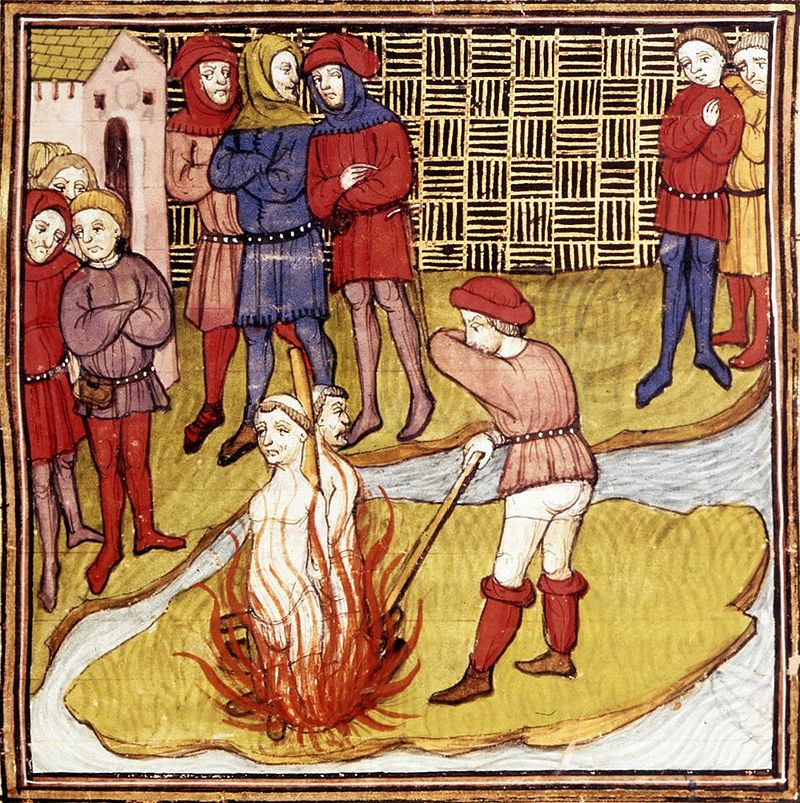1314 Burning of Jacques de Molay and Templar leaders
One of the most cynically evil acts in French history was the unjust prosecution of the Templar Order by King Philip IV. The enormously rich order had become the principal banker of the French monarchy, a regime which had ruthlessly squeezed all other sources of revenue. Its vast holdings and secrecy had aroused suspicion in the populace which saw that the order had lost its crusading zeal since being expelled from the Holy Land in the 1290s. This provided Philip with the opportunity of accusing the Knights of all kinds of perfidy: heresy, demon worship, sodomy, collusion with Muslim powers; 127 charges in all. The leadership of the Order was subjected to torture until they confessed to the accusations, setting the stage for a public condemnation in which they were to be sentenced to life imprisonment, but where Jacques de Molay upstaged the proceedings and regained his integrity at the cost of his life. According to a medieval account:
The cardinals dallied with their duty until 18 March 1314, when, on a scaffold in front of Notre Dame, Jacques de Molay, Templar Grand Master, Geoffroi de Charney, Master of Normandy, Hughes de Peraud, Visitor of France, and Godefroi de Gonneville, Master of Aquitaine, were brought forth from the jail in which for nearly seven years they had lain, to receive the sentence agreed upon by the cardinals, in conjunction with the Archbishop of Sens and some other prelates whom they had called in. Considering the offences which the culprits had confessed and confirmed, the penance imposed was in accordance with rule — that of perpetual imprisonment. The affair was supposed to be concluded when, to the dismay of the prelates and wonderment of the assembled crowd, Jacques de Molay and Geoffroi de Charney arose. They had been guilty, they said, not of the crimes imputed to them, but of basely betraying their Order to save their own lives. It was pure and holy; the charges were fictitious and the confessions false. Hastily the cardinals delivered them to the Provost of Paris, and retired to deliberate on this unexpected contingency, but they were saved all trouble. When the news was carried to Philippe he was furious. A short consultation with his council only was required. The canons pronounced that a relapsed heretic was to be burned without a hearing; the facts were notorious and no formal judgment by the papal commission need be waited for. That same day, by sunset, a pile was erected on a small island in the Seine, the Ile des Juifs, near the palace garden. There de Molay, de Charney, de Gonneville, and de Peraud were slowly burned to death, refusing all offers of pardon for retraction, and bearing their torment with a composure which won for them the reputation of martyrs among the people, who reverently collected their ashes as relics.
There is an interesting legendary postscript to these murders. As he was being incinerated, de Molay uttered a mighty curse. He laid a malediction upon King Philip, the royal advisor Guillaume de Nogaret, and Pope Clement, prophesying that they would all die with thin the year. All did. De Molay is also said to have cursed Philip’s family, and very shortly all of his sons died without heirs, leaving the dynasty extinct. These series events are recounted in Les Rois maudits (The Accursed Kings), a series of historical novels written by Maurice Druon.

I have always been intrigued by the Templers. I knew of their end previous to this and always thought this act of defiance their last bit of heroism.
I’m a proud member of the Knights of Columbus for two reasons (a) the chance to regularly do good deeds, and, (b) it’s my only chance at a Knighthood.
Seriously, KoC may be “your dad’s version” of the Templers, but its currently the only game in town.
Do the KofC folks still wear cloaks and swords? It’s a pity we Protestants have nothing similar.
Sadly, no, not regularly. For very special formal occasions, top leadership will don the traditional robes. Otherwise — blazer and slacks.